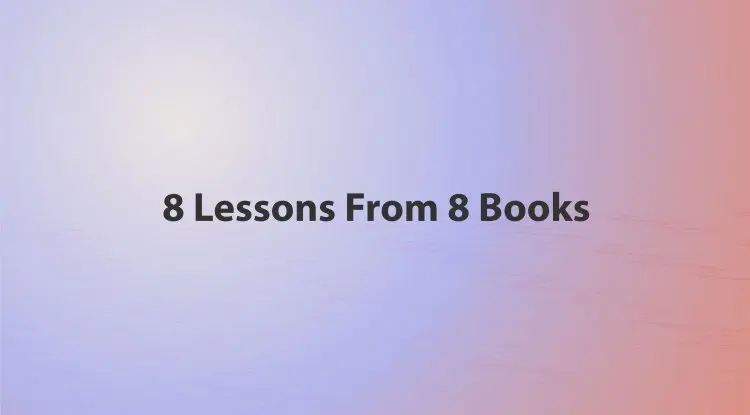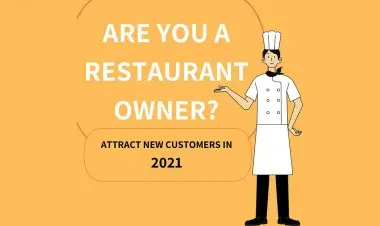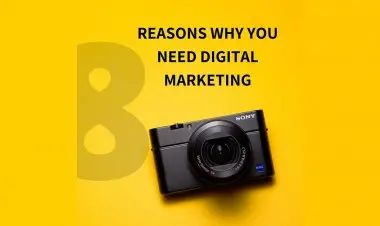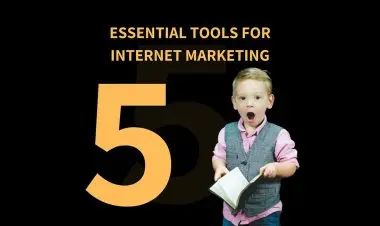8 Lessons From 8 Books
These inspirational books can change your life if you let them.

8 Lessons From 8 Books
- 7. BOOKS REFUGE
Humans are adaptation machines. We are literally designed to adapt to our environment and the stresses that it places on us (both physical and mental). Learning is the act of taking conscious control of this process, and books are the knowledge-based elixir of the gods when it comes to learning.
As Nelson Mandela said, "Education is the most powerful weapon we can use to change the world." The fact that millions of people have taken the time to better arm us, by writing down their hard-won knowledge in easily digestible tomes, is amazing.
Here are eight good books that fundamentally changed my worldview. I hope they can arm you and help you change the world.
If you don't act on what you learn, none of these books can help you. Before you read any book, you need to open yourself up to being changed forever by what you read. And wherever humanly possible, you need to put what you're learning to immediate use. I'm talking about using it within hours of reading it. If you do that, every book you read will further empower you and allow you to push yourself ever forward. They will allow you to take conscious control of your own evolution, and you'll be able to become whatever you want.
1. You control your attitude
Realize that your attitude is entirely up to you. Yes, you cannot control everything that happens to you, but you can control how you react to it.
Avoid negative news.
This doesn’t mean avoiding the mass media, although too much bad news is bad for all of us and time spent reading sad stories should be limited. To stay positive, stay aware of your surroundings. Stay away from people who only complain and just want to bring you down. Spend time encouraging people who want to see you succeed. Listen to positive podcasts. Read uplifting books and blog posts.
Realize that your attitude is entirely up to you.
You cannot control everything that happens to you, but you can control how you react to it. Take responsibility for that. This is a difficult task to master and may require the help of a therapist or a Women's group, but the benefits will be invaluable. Once you master feeling in control of your attitude, you will be more equipped to handle life’s unexpected unpleasantries.
Take action without expecting results.
While you naturally must make decisions and take action based on the results you'd like to achieve, it's a big mistake to expect those results and then be disappointed when you don't get them. Take your best shot but don't obsess about the target.
4. Use setbacks to improve your skills.
Rather than feeling bad if you fail or get rejected, look back at your actions and see what you can do (if anything) to improve your performance. Remember: the results you receive are the signposts for the results you want to achieve.
5. Seek out those who share your positive attitude.
It's a scientific fact your brain automatically imitates the behaviors of the people around you. (It's because of something called a Mirror neuron). Therefore, you should surround yourself with positive thinkers and shun those who are excessively negative.
6. Don't take yourself so seriously.
If you want to be happier and make those around you feel more comfortable, cultivate the ability to laugh at yourself. If you don't (or can't) laugh at yourself, I guarantee you that the people you work with are laughing behind your back!
7. Forgive the limitations of others.
High standards are important, but humans are, well, human. It's crazy to make yourself miserable because other people can't do a job as well as you think you could, or when people don't share your vision with the same passion that you feel.
8. Say "thank you" more frequently.
Achieving an "attitude of gratitude" requires more than simply being aware of what's wonderful in your life. You must, and should, thank other people for their gifts to you, even if that gift is something as simple as a smile.
2. BUILD-MEASURE-LEARN FEEDBACK LOOP
STEP 1: Define the idea that you want to test
STEP 2: Create a Minimum Viable Product
STEP 3: Measure the results that you obtained
STEP 4: Persevere or Pivot
Plan
The model may be called "Build-Measure-Learn" but, if you follow that sequence and jump in at the "Build" phase, you'll be missing the mark. Instead, it's essential to start with a planning stage.
Your first task is to define the idea that you want to test and the information that you need to learn. You do this by developing a hypothesis – your prediction of what will happen during the experiment.
Your hypothesis could focus on anything from product features and customer service ideas to finding the best pricing strategies and distribution channels. You might, for example, hypothesize that "increasing the frequency of our newsletters from two to four per month will increase overall revenue."
Next, decide what you'll need to measure to test your hypothesis, and plan how you'll collect your data. Interviews, surveys, website analytics, and specialized software programs are common methods for gathering data, and the BADIR process will help you to structure your study.
Build
Your goal here is to create a Minimum Viable Product(MVP) – the smallest possible product that allows you to test your hypothesis.
It could be a working prototype or a basic advertisement or a landing page. It could be a presentation slideshow, a mock brochure, a sample dataset, a storyboard, or a video that illustrates what you offer. Whatever MVP you choose, it needs to show just enough core features to attract the interest of early adopters – the people who'll likely want to buy your product as soon as it launches.
For example, the first 5,000 people who subscribed to the cloud-based file-sharing company Dropbox™ did so before its service was launched. They'd been convinced by the strength of Dropbox's MVP – a 90-second video explaining the service that it was about to offer.
Measure
The Build-Measure-Learn cycle is a feedback loop that is said to be one of the core components of the Lean Startup methodology. Its goal is to turn uncertainties, assumptions, and risks into knowledge or “sure things” that will eventually guide organizations and businesses towards progress. Through this process, the key unknowns can actually be transformed into knowledge that the startup can use in its product development – and business operations, as a whole. This whole process can also be called an experiment.
In order to understand how the Build-Measure-Learn cycle works, let us first take a look at its components.
Learn
This is where the startup will have to make a decision based on the measurements accumulated: should it “persevere”, or should it “pivot”? Persevere, in this context, means carrying on with the same goals, while pivot entails changing or shifting some, or all, of the aspects of the product strategy. Afterward, you would have to document your findings and share them.
The questions that are to be asked in this phase include looking into the knowledge that has been obtained. How should that knowledge be preserved?
More importantly, what is the next steps that should be taken by the startup?
Ries cited several activities for this phase including, but not limited to, conducting customer interviews, split tests, customer deployment, and smoke tests.
The 3 phases of the cycle can be simplified in the following activities.
- Ask whether the new idea of the startup actually solves a problem for the users.
- Quickly come up with an action or a program that will test the idea with the users. Perform reassessment or reevaluation if needed.
- Obtain feedback from your us Focus on getting information that is relevant and will be useful in helping you create the product/service that is wanted or needed by the users.
- Consider the sustainability of the product or service. Will you be able to maintain the current level of engagement or service?
3. Three Secrets of happiness
Secret 1: Blend your Ego (To feel more connected to yourself Cr Humanity)
Secret 2: Be Active (We are happiest when we are active)
Secret 3: Have Concrete & Manageable Goals.
Good relationship
Relationships are the spine that holds our lives together, even for the most isolated or introverted personalities, without human contact we will go crazy.
The quality of your relationships will determine the happiness and productivity of your life. A strong partnership will make your life mutually easier, allowing greater productivity. The less time spent worrying about the small details in life frees our consciousness to focus on the big picture and change the world.
You must ask yourself are your friendships, lovers, family, and co-workers adding to your life or making it harder? Like tearing off a bandaid, it’s not a nice process to remove someone ingrained in our lives, but we must be bold enough to do what’s best for ourselves, or we risk becoming emotional slaves to the negativity of others.
If this process brings someone to mind that has helped your progress, development, happiness, or even sanity. Take the time to remind the ones you love and who have helped you grow, what they mean to you.
Positive thinking
I’m obviously a big proponent of positive thinking as the best way to achieve your goals, but it turns out that it can lead to happiness too. Optimism and self-esteem are some of the best indicators of people who lead happy lives. Happy people feel empowered, in control of their lives, and have a positive outlook on life.
Action steps
Make positive thinking a habit. In fact, this should be one of the first habits you develop. Get into the habit of squashing all negative thoughts and replacing them with positive ones. Instead of “I can’t” think “I can”. It may sound corny, but it has worked for me, every time.
Flow State
Have you ever entered the ‘zone’ either at work or on a personal project, where you are so completely engrossed in what you are doing, that you lose track of time, so immersed in every detail that you produce your best work?
Finding something that allows you to enter a ‘flow state’ is an incredible creative outlet. Not only is it great for the mind, but pouring your heart into something will make you a more satisfied, happier human being. Find work, a hobby, a project that you are passionate about, and get to work.
If your day job leaves you feeling blank at the end of the day like you need a glass of wine just to recover for the next shift. Get out now.. Unfulfilling work will suck the life out of the happiest person. You deserve more. Switch off the TV, follow your passion, Find Your Flow and you will be on the way to being the happiest you’ve ever been.
You’ve been gifted the three secrets to happiness. Share them with someone you love, & most importantly. Don’t waste them!
4. Pursue what is meaningful
Life is suffering, but you can choose the things Er people worth suffering for. Set your values Fr priorities straight, nothing worthwhile can be achieved without sacrificing.
So suffering in life is inevitable. The universe can be unfair. In a hundred million years, nothing we do will likely matter. What does one do in the face of this knowledge?
One response is to take the expedient path. Indulge short-term pleasures and put off long-term commitments. Do what feels the best today – indulge your basest desires all the time. Even lie, cheat, and steal to get what you want. Do these things even if you know it makes your future self worse off than better.
Of course, we know this is what we shouldn’t be doing. We know we should be doing the hard things today to make our lives better in the future. We should suppress our immediate impulses to bring future rewards, like studying today and putting off partying to build the career we really want.
One obstacle is our powerful biological instincts – they kept us alive in the Stone Age, but they’re counterproductive today (overeating 100,000 years ago helped us survive a period of famine; today it leads to obesity). But on a higher conscious level, it’s hard to answer: why? How do we define what’s good and worth doing, and what isn’t?
A great book I have recently read is 12 Rules Of Life by Jordan Peterson, which offers some insightful views on life. In this book, Dr. Peterson applies the rules of the past and applies them to the present day. Much of what is talked about in the book refers back to the Bible and one of the best things about this book is that I have found how I can apply most of these rules to everything I do in life. Rule number seven for Dr. Peterson is “Pursue what is meaningful, not what is expedient”. “What does this have to do with CrossFit?” you might ask. The seventh rule applies to what we as coaches try to instill in our athletes every day. Just because something is faster, doesn’t mean it is better. I have had this conversation with multiple athletes over the years and it’s about time we address it head-on.
In the world of CrossFit, we often hear the word efficiency. We always want to be more efficient with our movement patterns. The definition of efficient is “the state of being able to accomplish something with the least waste of time and effort”. Oftentimes people confuse being efficient with cheating movement patterns. A classic example of this is Kettlebell swings. The movement of the kettlebell swing was designed to be a hip-driven, posterior chain strengthening movement. When doing a workout “for time” many people will cheat this movement by turning it into a pull/punch motion utilizing their arms rather than their hips in the motion; athletes tend to tell me it’s faster. Well, yeah, but you are missing the point. When we utilize the “fastest” way to do something, sure we have a fast time on the whiteboard but we didn’t get the training aspect of the workout. We missed the purpose of the workout. The pendulum motion of the kettlebell swing was designed to utilize the hamstring and hips to drive the kettlebell overhead. When done correctly, very little stress is put on the shoulders and elbows. This is just one example of how people confuse efficiency with proper movement patterns. Just because something may be faster, doesn’t make it right.
When you are in the controlled gym setting it is the job of the athlete and the coach to make a movement as perfect as possible for that athlete on that day. Shortchanging movements for the sake of getting a faster time is what will lead to injuries. This is the difference between competing and training. In training, I am trying to perfect movement patterns, whereas in competition I am trying to get as much done in the shortest amount of time. You should not be competing every day in the gym. Another common example is when athletes use a very narrow grip on power snatches during metcons. Yes, this may be faster in the short term but the transfer to the actual snatch movement is not there. If the movement patterns do not transfer over to something greater, then it is not efficient.
You are probably going to ask, “But Matt, what about Kipping pull-ups?” The goal is completely different in kettlebell swings and kipping pull-ups. In the former, I am trying to generate force through a certain muscle group but in the latter, I am trying to increase power production (power being force x distance divided by time, or work divided by time). Plus the kipping pull-up has many carryovers into other movements such as muscle-ups, toes to bar, and knees to elbows. The same cannot be said for the pull and punch version of Kettlebell swings or narrow grip snatches. This is a common misconception in the world of CrossFit. It must be clear what the goal is you are trying to achieve. I am a huge advocate that every workout performed must have a goal in mind. What is the goal and what is the desired end state?
Jordan Peterson had a very important idea when he wrote the rule “pursue what is meaningful and not what is expedient”. Just because something gives you a faster time today does not mean it is what is best for you in the long term. Our goal of CrossFit is movement perfection. I want to achieve as close to perfection as possible. This idea of moving towards virtuosity is meaningful, even if your time on today’s workout might be slower. Stop working out only to be on the top of the whiteboard, focus on training for something meaningful and not for being expedient and the results from that will speak for themselves.
5. BOOKS MY REFUGE
Doing fewer things in life will help you achieve better results
A concentrated effort towards your most valuable goals will help you achieve greater success.
Books have long been my refuge from the crazy, ugly real world. Now parts of the online reading community are eroding that safe place. 2014 was not a very good year for the reader. Readers were stalked and the stalking was celebrated in a major newspaper. There were dozens of smaller skirmishes and many vocal rallying cries for uncritical support of books and authors. There was a drumbeat, particularly from self-published authors, that readers exist to support the author.
It was also a year in which women were under attack. From being referred to as “binders full of women” to the horrific display of misogyny toward female gamers and gaming developers, the online community seemed especially vile. And it spilled over into the book community with regular ad hominem attacks being lobbed at readers for their reading choices, which had little to do with the books themselves for many times the critics hadn’t even read the books in question. Instead, the ad hominem attacks had more to do with the fact that the online discussion wasn’t about the books they felt were stronger, better, or worthier than these lesser ones being elevated and praised. Or it was authors who felt that readers didn’t appreciate or understand their work OR worse, assumed that the reader who didn’t like their work had a secret, evil agenda to bring that author down.
It’s enough to want to crawl back into one’s turtle shell and hide.
Dear Author is coming up on nine years of existence. It was established in April 2006 by Jayne and, because we wanted to talk about books, and specifically, we wanted to talk about books with other readers. That it has grown into what it is now pretty much astounds the both of us. Over the years I’ve made mistakes, mostly because I felt like I was still talking to my five friends about books.
And as Dear Author has grown, so have the headaches (and I’m not even talking about the lawsuit), to the extent that I’ve privately told individuals that I’m ready to throw in the towel and walk away from the blog. I’m not going to but I have those feelings. I’m sure many of you have those feelings because you’ve shared with me your frustration and discontent with the online community, with social media, and with the constant negativity in countless emails.
Internally, DA has had discussions about making a safe place for readers where we can talk without fear of reprisal. After weeks of thinking about this, I’ve come to the conclusion that we shouldn’t be afraid to speak about books. It’s booked. How did discussions about books become so fraught and dangerous that we have to hide away? I mean, that’s a bit ridiculous and a lot tragic, right?
Ultimately I understand that we want to talk about the books we love and those we don’t without judgment of us as people. From what I hear from others, we want to be able to share our feelings–both love and hate–without pissing people off. And I guess the question is whether that’s a reasonable expectation.
6. Happiness Comes Before Success
In order to have success, we need to be happy not the other way around.
When you are happy in the process you create a better future.
Dc. 19, 2005 -- Happiness may breed success rather than the other way around, according to a new study.
Researchers found happy people are generally successful in relationships, work, and health; this success is more often than not a result of their positive emotions rather than vice versa.
In a review of 225 studies on happiness and success, researchers found happy individuals are predisposed to seek out and undertake new goals in life, which often brings them more happiness as well as success in many aspects of their lives.
"This may be because happy people frequently experience positive moods and these positive moods prompt them to be more likely to work actively toward new goals and build new resources," says researcher Sonja Lyubomirsky, Ph.D., of the University of California, Riverside, in a news release. "When people feel happy, they tend to feel confident, optimistic, and energetic and others find them likable and sociable. Happy people are thus able to benefit from these perceptions."
Happiness May Spur Success
In their review, published in Psychological Bulletin, researchers looked at the links between desirable characteristics, life successes, and well-being in more than 275,000 people.
They analyzed information from three different types of studies, including:
- Studies that looked at happiness and success across different groups of studies.
- Studies that followed happiness and success over time to answer questions such as, "Does happiness precede success?"
- Studies that tested whether certain variables produce success or happiness.
The results of all three types of studies suggest that happiness leads to behaviors that often lead to further success in work, relationships, and health and that this success stems from these positive feelings.
Researchers found happy people benefit from several characteristics that make them prone to success, such as:
- A positive perception of themselves and others
- Creativity
- Highly social behavior
- A strong immune system
- Effective coping skills
Researchers say previous research has assumed that happiness flowed from success and accomplishments in life, but this study suggests that isn't always the case.
The Power Hack You Need
Humans are emotional by nature and sometimes we don’t feel our happiest. It happens to everyone. And while it can be tough to reset your attitude when you’re in a funk, there’s one power move that will always give you an instant boost. Try some smile therapy. Put on a smile before you speak. Even when you’re on the phone and no one can see you. They will be able to hear it in your voice. Plus as a bonus, smiling is contagious and friendly people are better at collaborating with each other to achieve positive outcomes. Sounds like a win-win.
Some days it can feel harder to crack a smile than on others. That’s ok too. We’ve got a scientific tip guaranteed to deliver an instant boost. Hold a pencil in your teeth for 30 seconds. This simple technique forces your face to imitate a genuine smile and tricks your brain into shifting your mindset. Studies show this easy move is linked to lowering stress levels and decreasing feelings of pain.* Even if it doesn’t boost your mood instantly, it can certainly help you handle the daily grind with more finesse.
Happiness Comes Before Success
The bottom line is that working happier matters. Happiness is a shared responsibility between companies and individuals. Some organizations are taking this philosophy so seriously they’ve created a new executive role to promote working happier with a Chief Happiness Officer (CHO). If you’re not working next to a CHO today, you still have a tremendous amount of influence over your own personal happiness. And since happier employees are 12% more productive, boosting your own happiness is key to accelerating your career.
*Kraft T & Pressman S (2012 in press). Grin and bear it: The influence of manipulated positive facial expression on the stress response. Psychological Science.
7. BOOKS REFUGE
Collect information about your problem
In order to have a clear view of your problems, collect all the possible information about what you can do Er what you can't do. Write it down, this activity will make your senses calm.
As the world confronts the largest refugee crisis since World War II, wealthy countries are being called upon to open their doors to the displaced, with the assumption that this will restore their prospects for a bright future. Refuge follows Syrians who fled a brutal war in their homeland as they attempt to rebuild in countries of resettlement and asylum. Their experiences reveal that these destination countries are not saviors; they can deny newcomers’ potential by failing to recognize their abilities and invest in the tools they need to prosper.
Heba Gowayed spent three years documenting the strikingly divergent journeys of Syrian families from similar economic and social backgrounds during their crucial first years of resettlement in the United States and Canada and asylum in Germany. All three countries offer a legal solution to displacement, while simultaneously minoritizing newcomers through policies that fail to recognize their histories, aspirations, and personhood. The United States stands out for its emphasis on “self-sufficiency” that integrates refugees into American poverty, which, by design, is populated by people of color and marked by stagnation. Gowayed argues that refugee human capital is less an attribute of newcomers than a product of the same racist welfare systems that have long shaped the contours of national belonging.
Centering on the human experience of displacement, Refuge shines needed light on how countries structure the potential of people, new arrivals or otherwise, within their borders.
8. Actions Fs thoughts must go parallel
Thoughts are just the start of the journey if you do not back up your thoughts with actions.
You will never be able to accomplish what you've thought of.
The problem with the argument
The argument is an inefficient slow and egotistical way of reasoning.
Let's say we were using the power of argument to decide on the direction of a project. I wanted to take it in 'Direction A' and you wanted to take it in 'Direction B'. I'd put forward the best ideas I could think of for 'Direction A'. You'd do the same for 'Direction B'.
Argument dictates this is a battle, a war, a way of us beating each other intellectually. The winner will take all. The loser will fall by the wayside. What's wrong with that? It dog eats dogs out there. Well, it's inefficient and slow. It also will not get the best out of either of us.
The winner in this method of decision making is the person whose argument goes unanswered. The person who can shout the loudest. The person who can think fast on their feet and articulate themselves well.
Imagine in the course of the argument I thought of something which might be a plus point for 'Direction B' there is no way I would say it. That would be like giving my enemy a battalion of troops with which to attack me. No. I'll keep quiet so that I win. And you lose.
All this back and forth going on the attack, countering the attack, and defending one's position is tiresome and immature.
Having to win an argument is superficial and counterproductive, especially in a situation where we are both on the same team - like in business.
The power of parallel thinking
Imagine four people all looking at a house from different angles - north, south, east, and west. Each person is asked to describe the house.
From the north side, it is described as having a chimney to the left and painted red. From the south, it is described as having a chimney to the right and being made of beautiful grey stone. From the east, it is described as having a huge red front door and six windows. From the west, it is described as being white, having eight windows and a small entranceway.
Each person's description is different based on their point of view. Yet they are all right and they are all looking at the same building. This is like the process of argument.
Now imagine we got all of the four people to stand at the north and look at the house. Then walk around to the West and describe it, then the South, and finally the East. Suddenly all of the descriptions would be aligned. They will have a full picture.
This is parallel thinking. A thinking process where the focus is split into specific modes of thought. Everyone in a group thinks in one way before moving to another. When done effectively it avoids the consequences of adversarial debate.
The objective is not to prove or disprove statements but to make the most observations that all can agree upon. This is more positive. More productive.
The winner in parallel thinking is the most observant contributor. The person who suggests the most ideas is based on the perspective the whole group is using. It is not the person who shouts the loudest.






